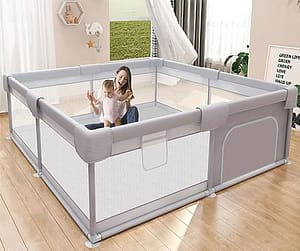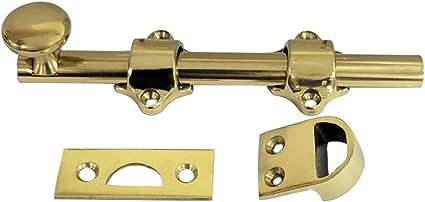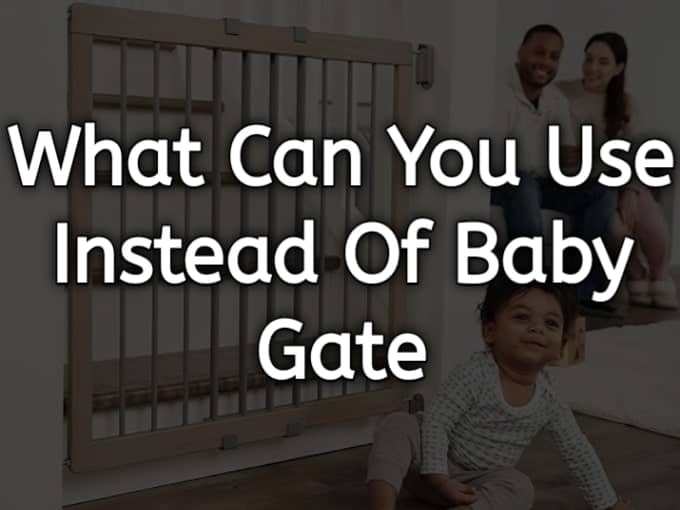Table of Contents
ToggleBaby gates are a staple in any home with little ones running around. Their primary function is to keep children safe by limiting their access to potentially harmful areas.
However, for various reasons, parents may seek alternatives. Perhaps you’re asking, “What can you use instead of a baby gate?” It’s a valid question, and we’re here to provide some solutions.
We’ve compiled a list of five safe alternatives to baby gates that ensure your children’s safety while offering convenience and aesthetic appeal.
Let’s delve into these alternatives.
What Can You Use Instead of Baby Gate? Here are 5 Alternatives:
1. Playpens:

Playpens, also known as play yards or playards, are an excellent alternative to baby gates. They come in various sizes, making them adaptable to different spaces.
Playpens are designed to provide a safe, enclosed area where your child can play and sleep.
The main advantage of a playpen is its versatility. It can be used indoors or outdoors, and it’s portable, so you can easily move it around your house or take it on trips.
They are also typically easy to set up and fold away when not in use, offering convenience for busy parents.
However, a potential downside of playpens is that they offer a smaller play area compared to a gated-off room.
As your child grows, they may become frustrated by the limited space. Plus, while many models are sturdy, they might not withstand a very determined toddler intent on escape.
In summary, a playpen can be a great alternative to a baby gate for providing an adaptable, portable, and safe play area.
But bear in mind the potential limitations regarding space and sturdiness.
For an in-depth comparison between baby gates and playpens, consider reading this comprehensive guide on Baby Gates vs. Playpens to help you make an informed decision.
2. Door Closers:

Another practical alternative to a baby gate is to install door closers. Door closers are mechanisms installed at the top of doors that close them automatically once they’ve been opened.
This tool can be particularly useful in homes where doors are constantly being left open, potentially allowing little explorers access to rooms they shouldn’t enter.
The key advantage of door closers is that they add an extra layer of safety by ensuring doors are always closed.
This can be particularly useful for restricting access to rooms with hazards, such as kitchens or bathrooms.
They are also relatively easy to install and don’t require large amounts of space like a baby gate or playpen might.
However, there are also drawbacks to consider.
Firstly, door closers can make it difficult for children to move freely from room to room, potentially causing frustration.
Secondly, unlike baby gates, they do not allow for visual monitoring as they completely close off the room.
Lastly, while they can prevent children from entering rooms, they won’t stop children from leaving a room if they manage to open the door.
In summary, door closers can serve as a useful substitute for baby gates by ensuring doors are always closed, thus restricting your child’s access to potentially dangerous rooms.
However, their use may limit your child’s freedom of movement and your ability to visually monitor them.
3. Dutch Doors:

A Dutch door, also known as a half door or a stable door, is a unique alternative to a baby gate.
This type of door is divided horizontally in such a way that the bottom half can remain shut while the top half opens.
Dutch doors can effectively replace baby gates by providing a barrier to prevent children from accessing certain areas, while still allowing for visual supervision and communication.
The main advantage of Dutch doors is that they integrate seamlessly into your home’s decor, eliminating the need for bulky baby gates.
Moreover, they allow for easy ventilation and maintain an open-air feel even when the bottom half is closed.
However, Dutch doors also have their downsides.
Firstly, they can be more expensive and complex to install compared to a simple baby gate.
Secondly, as your child grows and becomes more adventurous, they might figure out how to unlock and open the bottom half of the door.
Lastly, similar to door closers, Dutch doors do not allow for free movement between rooms, which can limit your child’s exploration and cause frustration.
In summary, Dutch doors can be an aesthetic and efficient alternative to baby gates. They effectively prevent children from accessing certain areas while enabling visual monitoring and open communication.
However, they can be costly, require professional installation, and limit your child’s mobility.
4. Safety Gates:

Safety gates, despite their similar name, serve a subtly different purpose than baby gates. They’re designed to block off potentially dangerous areas like staircases or fireplaces rather than limit a child’s freedom of movement within the house.
Safety gates can be a suitable alternative to baby gates, particularly in homes with specific areas of danger that need to be isolated.
The key advantage of safety gates is their robust build, often made of metal or sturdy plastic, making them more resistant to impact than typical baby gates.
They can be pressure-mounted for easy installation and removal, or hardware-mounted for added security.
Moreover, safety gates offer the flexibility of placement, allowing parents to strategically block off hazardous areas like staircases and fireplaces.
However, just like any other alternative, safety gates also come with their share of drawbacks.
Firstly, since safety gates are primarily designed to block off hazards, they may not offer the same area coverage as a baby gate.
Secondly, while they are great for maintaining child safety, they might not always blend well aesthetically with the home decor.
Lastly, similar to door closers and Dutch doors, safety gates can also limit a child’s mobility within the house, potentially causing frustration.
In summary, safety gates can be a viable alternative to baby gates, especially for homes with distinct areas of danger.
They offer a robust, flexible solution for childproofing your home but may also limit your child’s freedom of movement and not always complement your home decor.
5. Furniture to Block Access:
Using furniture to block off certain areas is a common and practical alternative to baby gates.
By strategically placing large items like couches, tables, or bookcases, parents can create a natural barrier that restricts a child’s access to potentially dangerous areas of the home.
One of the key benefits of using furniture as a barrier is that it offers a cost-effective solution.
There’s no need to purchase additional equipment, and it allows parents to make use of what they already have.
Additionally, furniture can be easily repositioned as needed, providing a flexible and adaptable solution.
Moreover, furniture barriers can blend seamlessly with the home decor, eliminating the aesthetic concerns often associated with baby gates.
They also allow free movement and visual monitoring while effectively creating a safe play area for children.
However, using furniture as a barrier is not without its drawbacks.
Firstly, not all furniture is suitable for this purpose. Items must be sturdy and heavy enough that a child can’t move them, and they mustn’t pose a tipping hazard. Furthermore, furniture with sharp corners or edges is not a safe choice.
Secondly, using furniture as a barrier doesn’t offer the same level of security as a dedicated baby gate or safety gate. A determined child might be able to climb over or squeeze around certain pieces of furniture.
Lastly, this method requires careful supervision. While furniture can act as a deterrent, it’s not foolproof, and a watchful eye is still necessary to ensure safety.
In summary, using furniture as an alternative to a baby gate can be an effective, low-cost solution that blends well with home decor.
However, it requires careful selection and supervision to ensure it provides a safe and secure barrier.
For more detailed information and creative ideas on how to block stairs without using baby gates, visit: this useful guide.
Conclusion:
In conclusion, there are several alternatives to the traditional baby gate that can be equally effective in keeping your child safe at home.
Door closers, Dutch doors, safety gates, and strategically placed furniture have all been presented as options that can prevent access to potentially hazardous areas while still allowing for freedom of movement and visual monitoring.
Door closers and Dutch doors are integrated solutions that can blend with your home decor, but they may be expensive, require professional installation, and potentially limit your child’s mobility.
On the other hand, safety gates are robust and flexible, ideal for homes with distinct danger areas, but they may not offer the same area coverage as a baby gate and may not always mesh well aesthetically with your home decor.
Using furniture as a barrier is a cost-effective and flexible solution that uses what you already have, but it requires careful selection and supervision to ensure safety.
It may not offer the same level of security as a dedicated baby gate or safety gate and might not deter a determined child.
In choosing between these alternatives, you should consider your budget, the layout of your home, and your child’s habits and temperament.
Whatever option you choose, remember that no solution is foolproof and that active supervision is paramount to ensure your child’s safety.

